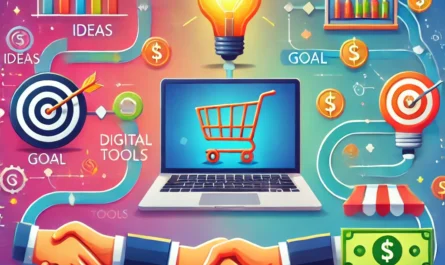Email marketing is one of the most powerful tools available to businesses today, providing a direct line of communication with potential and current customers. Understanding the core components of email marketing is the first step in creating a campaign that can lead to sustainable business growth. Unlike traditional marketing channels, email marketing allows businesses to engage with their audience in a more personal and targeted manner. It involves sending tailored messages via email to a group of recipients who have either subscribed to your mailing list or expressed interest in your brand.
When utilized effectively, email marketing enables businesses to cultivate relationships, nurture leads, and promote products and services, all while maintaining a high return on investment (ROI). In this guide, we’ll explore the foundational aspects of email marketing, how it can propel business growth, and the strategies needed to build successful campaigns.
The Role of Email Marketing in Business Growth
When executed strategically, email marketing can be a powerful driver of business growth. Its potential to deliver targeted messages directly to inboxes ensures that businesses can stay top-of-mind with their audience, nurturing both existing relationships and new leads. Through this platform, companies can promote new products, provide valuable content, and drive traffic to their websites, all while building long-term customer loyalty.
One of the most attractive features of email marketing is its ability to nurture leads by delivering relevant content at various stages of the buyer’s journey. Whether you are educating new leads, re-engaging previous customers, or promoting a special offer, email marketing provides a flexible platform to communicate with your audience on their terms.
In a crowded digital landscape, email marketing offers a solution for personalized engagement, which fosters stronger customer relationships and ultimately drives conversions. With the ability to segment audiences, automate campaigns, and track performance, businesses can optimize their email marketing strategies for measurable growth.
Benefits of Email Marketing for Businesses
Cost-Effectiveness
Email marketing is known for its cost-effectiveness compared to other forms of digital marketing, such as paid ads or social media campaigns. Many email marketing platforms offer affordable pricing plans that fit businesses of all sizes. Unlike traditional forms of marketing that require substantial financial investment, email marketing can yield high returns with relatively minimal cost.
For small businesses or startups working within tight budgets, email marketing can be particularly advantageous. With a well-thought-out strategy, businesses can connect with their audience, promote products or services, and drive traffic without the need for significant expenditures. This affordability makes it a key marketing channel, especially for businesses looking to maximize their marketing budget while achieving substantial results.
Targeted and Personalized Communication
One of the standout advantages of email marketing is its ability to deliver personalized messages that resonate with specific audience segments. Personalization in email marketing goes beyond addressing recipients by name—it includes tailoring content based on customer preferences, behaviors, and interests.
This type of targeted communication allows businesses to send highly relevant content, whether it’s promoting a product that aligns with a customer’s previous purchase history or offering educational material to someone who’s shown interest in a particular topic. Personalization boosts engagement rates, as recipients are more likely to open, click, and convert when the message speaks directly to their needs and preferences.
Creating an Effective Email Marketing Strategy
Building a successful email marketing campaign requires a well-planned strategy that aligns with your business goals. From identifying the right audience to choosing the appropriate tools, every step contributes to the campaign’s overall effectiveness.
Setting Clear Goals and Objectives
Before launching any email campaign, it’s essential to define your objectives. Are you aiming to grow your subscriber list, drive more traffic to your site, increase sales, or boost brand awareness? Having clear, measurable goals ensures that your email campaigns have a focused direction, which increases their chances of success.
Your goals will also influence the frequency, content, and design of your emails. For example, a campaign aimed at generating immediate sales might focus on promotional emails with clear calls to action, while a campaign designed to build brand loyalty may consist of newsletters filled with valuable content.
Choosing the Right Email Marketing Tools
To streamline your email marketing efforts and enhance the effectiveness of your campaigns, selecting the right tools is crucial. Today’s email marketing platforms offer features such as automation, segmentation, performance analytics, and customizable templates, all of which make it easier to manage your campaigns.
Platforms like Mailchimp, HubSpot, and Constant Contact offer user-friendly interfaces and advanced functionalities that allow businesses to automate their emails, track open rates, and analyze conversions. The right tool will not only save time but also provide valuable insights into how your audience interacts with your emails, enabling continuous improvement.
Building a Quality Email List
A successful email marketing campaign begins with building a strong email list. Quality always outweighs quantity when it comes to email lists. Instead of purchasing email lists, which often lead to low engagement and spam complaints, focus on organically growing your list through ethical means.
Organic Methods to Build Your Email List
The best way to grow your email list is by offering value to your audience in exchange for their contact information. This can be achieved through lead magnets such as free eBooks, discounts, exclusive access to webinars, or other incentives that are valuable to your target audience.
Optimized landing pages, pop-up forms, and engaging blog content that encourages visitors to subscribe are also effective ways to grow your email list. Be transparent about what subscribers can expect from your emails, whether it’s promotional offers, valuable tips, or updates about new products.
Importance of Segmentation and Targeting
Not all subscribers have the same needs or interests, which is why segmentation is a powerful strategy in email marketing. By dividing your list based on factors such as demographics, purchase behavior, or engagement level, you can send more targeted emails that speak to the specific needs of each group.
For example, a customer who recently purchased from your online store may receive follow-up emails about complementary products, while a new subscriber might be nurtured with informative content or introductory offers. Segmentation ensures that your message is relevant, which significantly improves open rates, click-through rates, and conversions.
Crafting Compelling Email Content
The content within your email is the heart of your campaign. Your subscribers are more likely to engage with your emails if the content is valuable, relevant, and visually appealing.
Writing Attention-Grabbing Subject Lines
Your subject line is the first thing your subscribers see, and it can determine whether they open the email or not. Creating short, engaging, and intriguing subject lines can significantly boost your open rates. Subject lines that evoke curiosity, urgency, or personalization are often the most effective.
Avoid clickbait tactics, but make sure your subject line reflects the value inside the email. For instance, a subject line like “Last Chance: 50% Off Your Favorite Products!” combines urgency with an enticing offer, encouraging the reader to take action.
Engaging Copy and Visuals for Emails
Once you’ve piqued your subscriber’s interest with a compelling subject line, the content inside the email must continue to engage them. Focus on creating concise, benefit-driven copy that clearly communicates your message. Highlight how your product or service can solve a problem or meet a need for your audience.
Visual elements such as images, GIFs, and videos can also make your emails more engaging. However, ensure that these visuals are optimized for quick loading and complement the written content without overwhelming it.
Personalization and Automation in Email Marketing
Personalization and automation are two of the most powerful tools in an email marketer’s arsenal. Together, they enable you to send the right message at the right time, driving engagement and conversions with minimal manual effort.
Using Personalization to Drive Engagement
Personalized emails, tailored to each subscriber’s interests, are far more effective than generic mass emails. Personalization goes beyond adding the recipient’s name to the email. It includes offering recommendations based on previous purchases, sending birthday discounts, or providing content aligned with the subscriber’s interests.
When subscribers feel that the email was specifically crafted for them, they are more likely to engage with the content, click on links, and take the desired action.
Automating Emails for Better Efficiency
Email automation allows businesses to send triggered emails based on user actions, such as signing up for a newsletter, making a purchase, or abandoning a cart. Automated workflows, such as welcome series or re-engagement campaigns, ensure that the right message is sent at the optimal time, increasing the likelihood of engagement.
Automation not only saves time but also ensures a consistent experience for your subscribers, improving customer satisfaction and retention.
You Can Also Read : How to Manage Cash Flow for Small Businesses
Avoiding Spam Filters and Ensuring Deliverability
One of the biggest challenges in email marketing is ensuring your emails land in your subscribers’ inboxes, not their spam folders. To avoid this, follow best practices like using a reputable email marketing tool, avoiding spammy language, and keeping your list clean of inactive or invalid emails.



